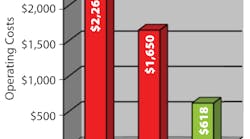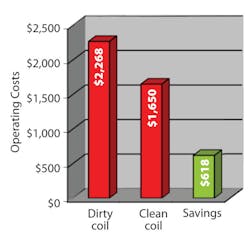Air conditioning and refrigeration coils are sized to match the BTUH cooling requirements of a home or building. Both the condenser and the evaporator coils are engineered to provide optimum heat transfer as required by the area being cooled. Optimum heat transfer and system efficiency, however, is predicated on clean coil surfaces.
The air moving across these coils will in most cases, contain soils such as dust, dirt, pollen, grease, and moisture. Airborne contaminants will settle on the coil surfaces, adversely affecting the coils’ ability to transfer heat. Pollen, bacteria, and mold spores on the evaporator coil will not only reduce heat transfer but will also affect the quality of the air within a home or building.
In addition, the cost of operating dirty air conditioning and refrigeration equipment is greater than you or your customer might suspect. Dirty condenser coils increase power costs. When the coil becomes fouled with dirt and grime, it cannot provide its designed — or, in some cases, even adequate — heat transfer.
Soiling insulates the coils, increasing discharge pressures. Higher discharge pressures increase the amperage draw and run time of the compressor, while simultaneously reducing capacity. Equipment operating with dirty coils can use more than 30% more energy than equipment with clean coils.
The Costs of Dirty Coils Add Up
The cost of dirty coils goes beyond energy use. As dirt and grime collect on the condenser, they restrict heat transfer and cause the compressor to work harder. This adds more heat to the system and causes the head pressure to rise. Rising head pressure will result in a loss of cooling capacity of up to 30%. A 10-ton system with a 30% loss provides only 7 tons of cooling. This loss of capacity will typically be most noticeable on the hottest days when cooling is needed the most.
The bad news does not stop there. Higher operating pressures and temperatures caused by a dirty coil may reduce the equipment’s life expectancy. The elevated system temperature and pressure may lead to the breakdown of the compressor’s lubricant. In addition, acid formation can occur, leading to an acid burnout. Lubricant breakdown and acid formation will seriously compromise the compressor and ultimately lead to equipment failure. Compressor failure means no cooling. No cooling means no comfort for the home or building occupants. And, compressor replacement means a considerable cost to the home or building owner.
Coil cleaning and preventive maintenance enables the servicing technician to offer his or her customers the following benefits:
• Significant energy savings
• Peak equipment efficiencies
• Enhanced reliability
• Longer service life
• Reduced breakdowns
• Improved indoor air quality.
A less tangible yet important benefit is energy conservation. If a large number of systems were properly maintained, significant energy savings would be realized. This energy savings would be most significant in times of high energy demand: the hottest days of the year, when comfort cooling is most critical. Many home and building owners welcome opportunities to practice conservation, specifically in cases when they will realize savings without sacrificing comfort. Most of these equipment owners are unaware of the significant energy savings and comfort benefits of a regular coil cleaning and maintenance program.
Choosing the Right Cleaner
Coil cleaners are divided into two categories, acid and base (alkaline).
Acid types are typically made with hydrofluoric acid. They are typically much more dangerous than alkaline types and not recommended by most equipment OEM. The alkaline group is divided into caustic, foaming coil cleaners and non-foaming detergent cleaners. Typically, the difference between the two is that the caustic type uses sodium hydroxide and tends to be a little more aggressive then the detergent types.
Always match the coil cleaner to type of cleaning required. Contact your local HVACR wholesaler for specific answers to any questions you might have along these lines.
As Always, Safety Comes First
Safety is always the utmost important practice when working with any chemical cleaners. Face shields with head protection, chemical gloves, and a respirator mask are for your protection. Proper clothing will also be needed to protect exposed skin areas. Chemical-resistant safety boots protect your feet when standing near coils during the cleaning application and the rinsing away of any residual cleaners.
Keep all MSDS in a clear protective cover fastened in the same storage area as the chemicals within your service vehicle, and be prepared to handle first aid emergencies in case of an accident. Review these safety procedures annually.
Green Coil Cleaners
As the “green” movement becomes more and more popular, Eco-friendly coil cleaners have become more widely available. Any coil cleaner making an eco-friendly claim should be U.S. Environmental Protection Agency and Design for the Environment (DfE) recognized. Simply look for the DfE logo on product packaging. Or visit www.epa.gov/oppt/dfe/ for more information.
Green products are typically developed with all natural ingredients derived from vegetable esters and other eco-friendly resources. They have been tested extensively to ensure the highest level of performance while utilizing green ingredients. In addition, the products are biodegradable and will not harm plants, animals, and aquatic life. More importantly, they use only natural and renewable resources that are on the DfE list of acceptable green ingredients.
Whether you choose acids, alkalines, or greens, be aware that many factors go into the decision-making process to determine what coil cleaner to use. Don’t just pick any one off the shelf and expect it to handle all your needs.
Don’t Forget Indoor Air Quality Issues
A fouled and dirty evaporator coil creates an excellent harbor and breeding ground for bacteria and mold that can impact a building’s indoor air quality. Cleaning, sanitizing, and protecting the evaporator coil, condensate pan, and surrounding areas is critical. Care should be taken to use the proper indoor cleaners and to treat surfaces with the proper EPA-registered products created for the HVAC industry.
An IAQ perspective will enhance the health, safety, and comfort of the home or building for its occupants.
In addition to the coils, another location in a system that is prone to the build-up of bacterial slime is the condensate pan. As condensate collects in the pan, it can become a breeding place for harmful bacteria. This build-up can cause odor as well as plugged drains and overflows, which in turn can cause water damage. There are multiple products to prevent this bacterial slime from building up in condensate pans and causing these problems.
Cleaning coils and condensate pans and showing customers the value of a coil-cleaning preventive maintenance plan is the first step in helping them solve any IAQ issues they could be having. Don’t underestimate the importance of these steps.











